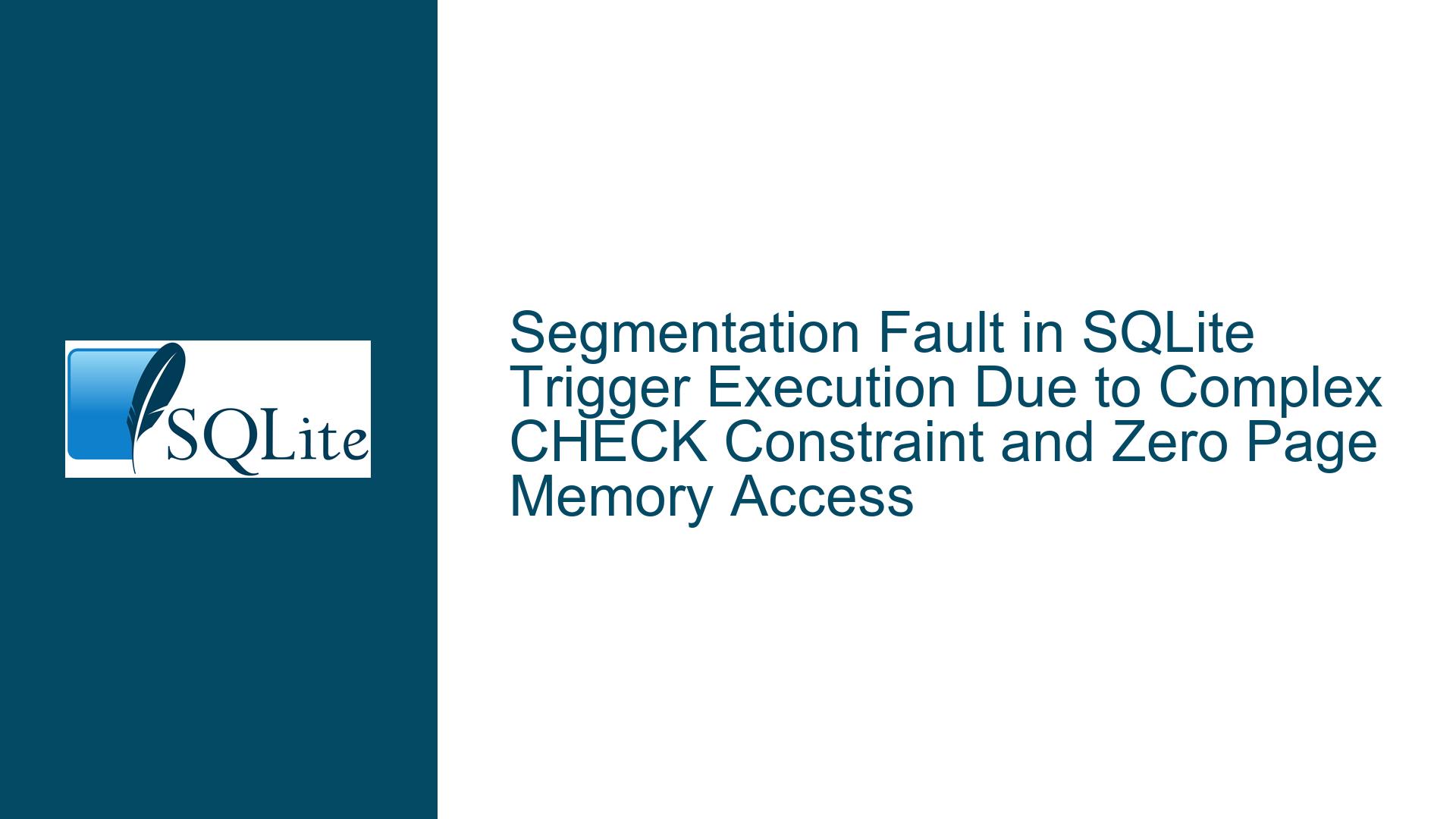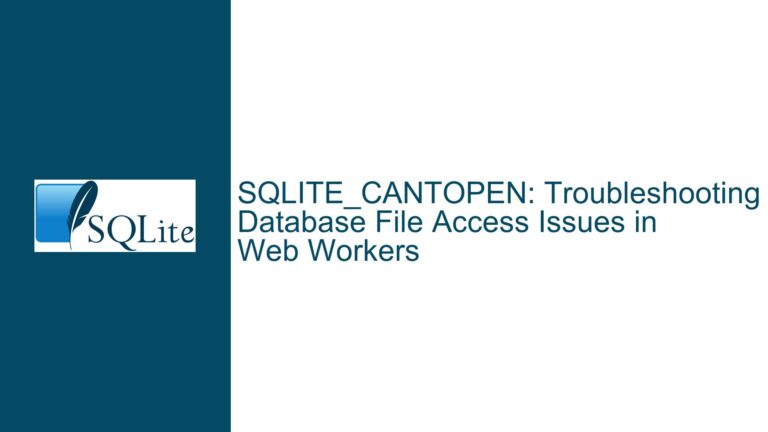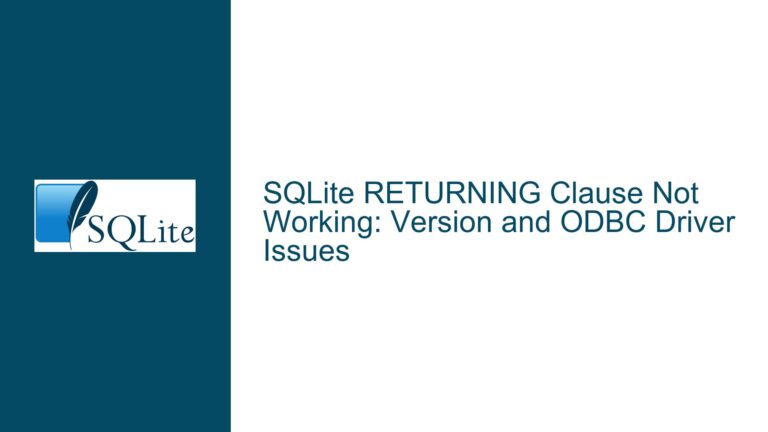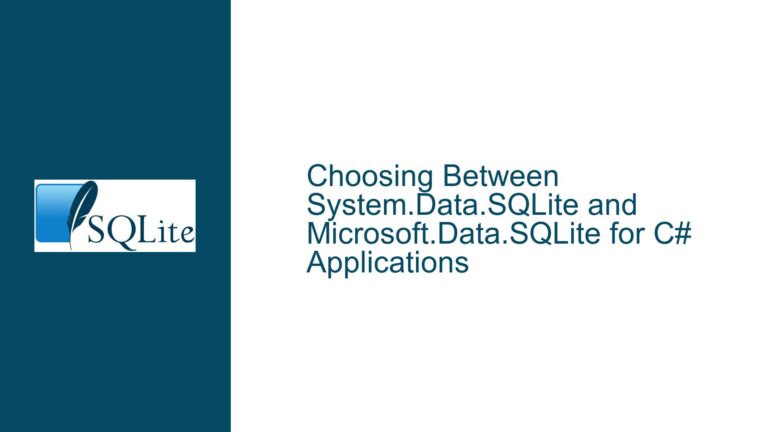Segmentation Fault in SQLite Trigger Execution Due to Complex CHECK Constraint and Zero Page Memory Access
Segmentation Fault During Trigger Execution with Complex CHECK Constraint
The issue at hand involves a segmentation fault occurring during the execution of a SQLite trigger, specifically when a complex CHECK constraint is applied to a table column. The fault manifests when the SQLite Virtual Database Engine (VDBE) attempts to append a P4 operand to a VDBE instruction, resulting in a memory access violation. This violation is detected by AddressSanitizer, which reports a segmentation fault (SEGV) due to a write operation targeting the zero page memory address (0x000000000000). The fault is triggered during the execution of a series of SQL commands, including the creation of a table with a complex CHECK constraint, the creation of triggers, and the insertion of data into the table.
The CHECK constraint in question involves a nested expression that includes zeroblob functions, arithmetic operations, and logical comparisons. The trigger, which is set to execute after an insert operation on the table, attempts to perform a SELECT statement with a window function that includes a count(count()) expression. This combination of complex constraints and trigger logic appears to overwhelm the SQLite engine, leading to the segmentation fault.
The segmentation fault is particularly concerning because it indicates a low-level memory access violation, which can lead to unpredictable behavior, including data corruption, application crashes, and potential security vulnerabilities. The fault is reproducible across different platforms, including Ubuntu 19.10 and macOS 11.2.1, and occurs with both SQLite version 3.35.0 and version 3.32.3.
Interrupted Write Operations and Zero Page Memory Access Leading to Segmentation Fault
The segmentation fault is caused by a combination of factors, including interrupted write operations, improper handling of memory allocation failures, and an attempt to write to the zero page memory address. The root cause can be traced back to the sqlite3VdbeAppendP4 function, which is responsible for appending a P4 operand to a VDBE instruction. The function attempts to write to a memory location that is either invalid or has not been properly allocated, leading to the segmentation fault.
The CHECK constraint’s complexity plays a significant role in triggering the fault. The constraint involves multiple nested zeroblob functions, which are used to create binary large objects (BLOBs) of a specified size. The zeroblob function is typically used to allocate space for BLOBs that will be filled with data later. However, in this case, the zeroblob functions are used in a way that may not be intended, leading to unexpected behavior. The nested nature of the constraint, combined with the logical comparisons and arithmetic operations, creates a scenario where the SQLite engine may fail to properly allocate memory or handle memory allocation failures.
The trigger’s logic further exacerbates the issue. The trigger attempts to perform a SELECT statement with a window function that includes a count(count()) expression. This expression is not valid SQL syntax and may cause the SQLite engine to enter an undefined state. The use of the @v1 variable in the ORDER BY clause of the window function is also problematic, as it is not a valid SQLite variable reference. This combination of invalid syntax and improper variable usage can lead to memory corruption and, ultimately, the segmentation fault.
The segmentation fault is also related to the SQLite engine’s handling of memory allocation failures. The p->db->mallocFailed condition is checked in the sqlite3VdbeAppendP4 function, indicating that the engine is aware of potential memory allocation issues. However, the engine may not be properly handling these failures, leading to the attempt to write to the zero page memory address. This suggests a potential bug in the SQLite engine’s memory management logic, particularly in the context of complex constraints and triggers.
Implementing Memory Safety Checks and Simplifying Complex Constraints
To address the segmentation fault, it is necessary to implement memory safety checks and simplify the complex constraints and triggers that are causing the issue. The following steps outline the troubleshooting process and potential solutions:
1. Update SQLite to the Latest Version: The issue appears to have been fixed in a later version of SQLite. Specifically, the problem was addressed in a check-in on 2021-01-21 (check-in 02264ab6a02d6cc9). Updating to a version of SQLite that includes this fix should resolve the segmentation fault. It is recommended to always use the latest stable version of SQLite to benefit from bug fixes and performance improvements.
2. Simplify the CHECK Constraint: The complex CHECK constraint that involves nested zeroblob functions, arithmetic operations, and logical comparisons should be simplified. The use of zeroblob in this context is unconventional and may not be necessary. Consider breaking down the constraint into simpler, more manageable components. For example, instead of using nested zeroblob functions, use explicit checks and logical comparisons that are easier for the SQLite engine to evaluate.
3. Validate Trigger Logic: The trigger logic should be reviewed and validated to ensure that it adheres to valid SQL syntax. The use of count(count()) in the window function is not valid SQL and should be replaced with a valid expression. Additionally, the use of the @v1 variable in the ORDER BY clause should be corrected. Variables in SQLite are typically prefixed with a colon (:) or dollar sign ($), and their usage should be consistent with SQLite’s variable binding mechanisms.
4. Implement Memory Safety Checks: The SQLite engine should be modified to include additional memory safety checks, particularly in the sqlite3VdbeAppendP4 function. These checks should ensure that memory allocations are successful before attempting to write to memory locations. If a memory allocation fails, the engine should handle the failure gracefully, either by aborting the operation or by providing a fallback mechanism.
5. Use PRAGMA Statements for Debugging: SQLite provides several PRAGMA statements that can be used to debug and optimize database operations. For example, the PRAGMA integrity_check statement can be used to verify the integrity of the database, while the PRAGMA foreign_key_check statement can be used to check for foreign key constraints. These PRAGMA statements can help identify potential issues in the database schema and trigger logic.
6. Test with AddressSanitizer: AddressSanitizer is a memory error detector that can help identify memory access violations, including segmentation faults. The SQLite engine should be tested with AddressSanitizer enabled to identify any additional memory-related issues. The ASAN_OPTIONS environment variable can be used to configure AddressSanitizer’s behavior, such as enabling leak detection and setting the halt-on-error option.
7. Review and Optimize Schema Design: The database schema should be reviewed and optimized to ensure that it is efficient and free from unnecessary complexity. Complex constraints and triggers should be avoided unless absolutely necessary. Consider using simpler, more straightforward schema designs that are easier for the SQLite engine to process.
8. Monitor and Analyze Logs: SQLite provides logging mechanisms that can be used to monitor and analyze database operations. The sqlite3_log function can be used to log messages to a file or console, providing valuable insights into the engine’s behavior. These logs can be analyzed to identify potential issues and optimize database performance.
9. Consider Alternative Database Engines: If the segmentation fault persists despite implementing the above solutions, it may be necessary to consider alternative database engines. Lightweight databases such as SQLite are designed for simplicity and ease of use, but they may not be suitable for all use cases. Consider using a more robust database engine, such as PostgreSQL or MySQL, if the application requires complex constraints and triggers.
10. Engage with the SQLite Community: The SQLite community is an invaluable resource for troubleshooting and resolving issues. Engage with the community through forums, mailing lists, and other channels to seek advice and share experiences. The community can provide insights and solutions that may not be immediately apparent.
By following these troubleshooting steps and implementing the suggested solutions, the segmentation fault can be resolved, ensuring the stability and reliability of the SQLite database. It is important to approach the issue methodically, addressing each potential cause and verifying the effectiveness of each solution. With careful analysis and optimization, the SQLite engine can be made more robust and capable of handling complex constraints and triggers without encountering segmentation faults.





